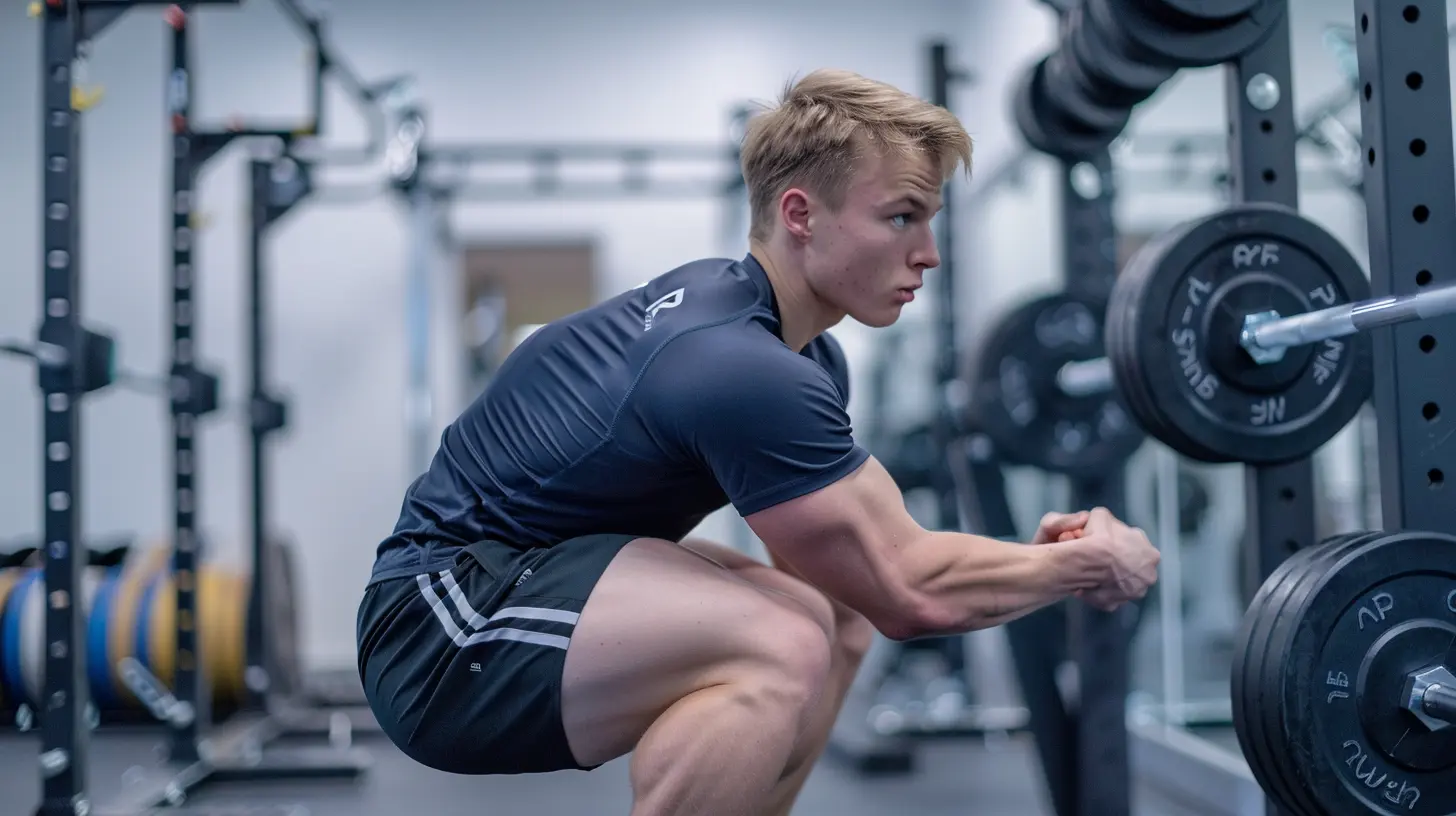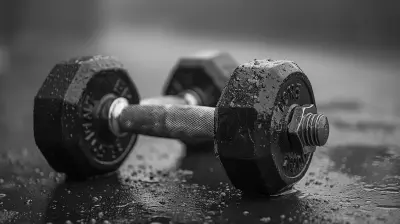How to Train Around Injuries and Still Build Strength
7 March 2025
Injuries can be frustrating. One minute you're lifting heavy, pushing your limits, and feeling like a beast—then bam! You’ve pulled a muscle or tweaked your back. It’s like hitting a wall, right? But here's the thing... getting injured doesn’t mean your strength training journey has to come to a screeching halt. Sure, you’ll need to adjust, but you can still make progress, build strength, and stay in the game while you recover.
So, how do you train around injuries and still build strength? Let’s dive into it.

Listen to Your Body
First things first—listen to your body. Sounds obvious, right? But it’s easier said than done. We often think we're invincible and push through pain, thinking it'll just go away. Spoiler alert: it doesn’t. Pain is your body’s way of telling you something’s wrong, and continuing to train through it can make things worse.If you’re dealing with an injury, take a step back and assess how severe it is. Is it just a little soreness, or is it something more serious? If it's the latter, you might want to consult a professional, like a physical therapist or doctor, before continuing with your training. But don’t worry—you’re not sidelined for good.
Know the Difference Between Pain and Discomfort
There’s a big difference between the discomfort you feel when you're working hard and the sharp, stabbing pain of an injury. Discomfort is that burning sensation in your muscles when you're pushing through those last few reps—it’s a sign you're growing stronger. Pain, on the other hand, is a red flag. If you feel anything sharp or sudden, especially in your joints or back, it's a sign to stop.Training around an injury requires you to be in tune with your body. Know when to push and when to pull back. It’s a balancing act, but once you get the hang of it, you’ll be able to keep moving forward without causing further damage.

Modify, Don't Avoid
When you're injured, the temptation to skip the gym altogether can be strong. But you don’t have to throw in the towel. Instead, modify your workouts. There are always workarounds to keep you in the game.Let’s say you’ve injured your shoulder. Sure, overhead pressing or bench pressing might be off the table for now, but that doesn’t mean you can’t work your lower body or even other parts of your upper body. Leg exercises like squats, lunges, and deadlifts can still be part of your routine. Heck, you might even find new exercises you wouldn’t have tried otherwise!
The key here is to find alternative movements that don’t aggravate the injured area while still targeting the muscles you want to work on.
Focus on Unaffected Areas
Just because one part of your body is injured doesn’t mean the entire body needs to rest. You can still train the unaffected areas. For example, if you’ve pulled a hamstring, why not focus on upper body exercises? If your shoulder's out of commission, it’s a great time to work on your legs.One bonus here is that training other areas can actually help speed up your recovery. By keeping the blood flowing and maintaining your activity levels, you support overall circulation and healing. Plus, let’s be real: staying active will keep your spirits up and help you feel like you’re still making progress.

Keep the Intensity in Check
As much as we all love to go hard in the gym, training through an injury is not the time to push for personal records. Think of it like driving your car with a flat tire—if you keep speeding, you’re going to cause more damage.Instead, dial back the intensity. Lower the weight, slow down the tempo, and focus on good form. It might feel like you’re not doing enough, but trust me, staying consistent is more important than chasing heavy lifts when you're injured. It's all about maintaining your momentum without making the injury worse.
Focus on Technique and Form
Injuries provide the perfect opportunity to revisit your technique. Often, injuries happen because of poor form or overloading. Now’s the time to really hone in on your movement patterns.You might even find that fixing your form helps prevent future injuries. For example, if you injured your back while deadlifting, reducing the weight and focusing on proper hip hinge mechanics could make all the difference when you're healed and ready to go heavy again.

Incorporate Mobility and Flexibility Work
Injury or not, mobility and flexibility are often the unsung heroes of strength training. Most of us skip them because they’re just not as fun as lifting heavy weights. But when you’re trying to train around an injury, improving your mobility and flexibility can actually help speed up recovery and prevent future issues.Stretching and Foam Rolling
Take some time to stretch the injured area (if it’s safe to do so), as well as the surrounding muscles. Foam rolling can also be a great tool to release muscle tightness and improve blood flow to the injured site. Just make sure you're not rolling directly on a joint or a really tender area.Yoga and Active Recovery
Yoga is another fantastic option when you're dealing with an injury. It helps with flexibility, balance, and mobility, all while providing a low-impact way to stay active. And let’s not forget the mental benefits—yoga can help you stay calm and focused, which is crucial when you're feeling frustrated by an injury.Strengthen Your Weak Links
Injuries often expose weaknesses in our bodies. Maybe your core wasn’t as strong as you thought, or perhaps your glutes weren’t firing properly during squats. Whatever the case, now’s the time to address these weak links.Use your injury as an opportunity to strengthen those areas that might have been neglected. If you have a lower body injury, think about working on your core or upper body stability. If it’s an upper body injury, focus on your legs or your posterior chain. Strengthening these weak points will not only help you recover but also make you a stronger, more balanced athlete moving forward.
Stay Positive and Patient
Let’s be real—injuries suck. They can make you feel like you’re losing all the progress you've worked so hard for. But that’s where mindset comes into play. It’s easy to get discouraged, but focusing on the things you can do will keep you motivated.Recovery takes time, and it’s important to be patient with yourself. Strength training is a marathon, not a sprint. Think of this time as a detour, not a dead end. Your body is resilient, and with the right approach, you’ll come back stronger.
Set New Goals
Instead of focusing on what you can’t do, set new goals that align with your current abilities. For example, if you can't lift heavy weights right now, make mobility or flexibility a priority. Maybe you aim to perfect your squat form or improve your balance.Having something to work towards will keep you motivated and focused, even if your training looks a little different than usual.
Stay Active Mentally
While you may be physically limited, that doesn’t mean you can’t stay active mentally. Use this time to educate yourself on strength training, injury prevention, and recovery methods. Dive into books, podcasts, and articles that will help you come back even better than before.
Consult a Professional
If you’re not sure how to modify your workouts or if you’re dealing with a more serious injury, don’t hesitate to consult a professional. A physical therapist or a knowledgeable coach can help you create a training plan that allows you to recover while still building strength.Having an expert in your corner can make all the difference in ensuring that you're doing everything you can to heal properly while continuing to make progress.
Conclusion: Injuries Are Setbacks, Not Stop Signs
At the end of the day, injuries are frustrating but not the end of the road. With the right approach, you can train around them and still build strength. Listen to your body, modify your workouts, focus on technique, and take the time to address any weak links. Stay positive, be patient, and remember—this is just a detour on your strength training journey, not the final destination.So, are you ready to keep moving forward?
all images in this post were generated using AI tools
Category:
Strength TrainingAuthor:

Everett Davis
Discussion
rate this article
16 comments
Sarah Collins
Great tips! Staying positive while training around injuries can be a game-changer. Let’s keep building strength and staying strong together! 💪✨
April 4, 2025 at 8:30 PM

Everett Davis
Thank you! Staying positive truly makes a difference. Let's keep pushing forward together! 💪✨
Dax Campbell
This article offers invaluable insights on adapting training regimens around injuries. Emphasizing the importance of listening to one's body and maintaining a positive mindset, it encourages athletes to focus on alternative exercises that promote healing while still fostering strength. A proactive approach can yield impressive results.
March 28, 2025 at 2:07 PM

Everett Davis
Thank you for your thoughtful comment! I'm glad you found the insights helpful for training while dealing with injuries. Listening to your body is indeed crucial for both recovery and continued strength development.
Wendy Gonzalez
Listen to your body; adaptability fosters strength during recovery and beyond.
March 25, 2025 at 4:45 AM

Everett Davis
Absolutely! Listening to your body is crucial; it helps you adapt and build strength safely during recovery.
Ursula Vance
Injuries are setbacks, not dead ends. Embrace creative training, push boundaries, and build resilience. Strength isn’t just physical; it’s your unwavering spirit!
March 23, 2025 at 8:34 PM

Everett Davis
Absolutely! Embracing creativity in training during setbacks not only fosters resilience but also enhances overall strength—both physically and mentally. Keep pushing forward!
Benjamin Luna
Prioritize rehabilitation, adapt workouts, and focus on unaffected muscle groups.
March 23, 2025 at 3:24 AM

Everett Davis
Absolutely! Prioritizing rehabilitation and adapting workouts is key to safely maintaining strength while recovering from injuries. Focus on unaffected muscle groups to ensure balanced progress.
Caitlin Montgomery
Great tips! Remember, even while injured, your strength journey isn't over—just a new path to explore. Keep pushing forward! 💪
March 22, 2025 at 12:08 PM

Everett Davis
Thank you! Absolutely, injuries can lead to new opportunities for growth and strength. Keep moving forward! 💪
Indigo McMahon
Training around injuries is like navigating a minefield; careful strategy is key. Focus on what you can do, not what you can't. Embrace alternative methods, prioritize recovery, and remember: strength isn't just about lifting weights, it's about lifting your mindset. Adapt and conquer!
March 21, 2025 at 4:14 AM

Everett Davis
Thank you for your insightful comment! Emphasizing a positive mindset and adaptive strategies is crucial for training around injuries while still making progress.
Martha McFee
Injuries don’t have to derail your progress. Focus on adapting your training to strengthen uninjured areas while allowing your body to heal. Embrace cross-training, mobility work, and bodyweight exercises. With the right mindset and a strategic approach, you can emerge stronger and more resilient than ever. Keep pushing forward!
March 19, 2025 at 8:56 PM

Everett Davis
Thank you! Emphasizing adaptation and resilience is key. Cross-training and focusing on what you can do will definitely help maintain strength and promote healing.
Eli James
Training around injuries requires a strategic approach, focusing on alternative exercises that maintain strength without aggravating the affected area. Prioritizing proper form and recovery is essential to enhance overall performance while minimizing further risk.
March 17, 2025 at 10:01 PM

Everett Davis
Absolutely! A strategic approach that includes alternative exercises, careful focus on form, and prioritizing recovery is key to training safely and effectively around injuries.
Anisa McClendon
Training around injuries requires creativity and adaptability. Focus on maintaining strength in unaffected areas, prioritize mobility, and consult professionals to tailor a safe, effective regimen that promotes recovery and resilience.
March 16, 2025 at 6:02 AM

Everett Davis
Absolutely! Injury training demands creativity and adaptability—focus on maintaining strength in unaffected areas, prioritize mobility, and always consult professionals for a tailored recovery plan.
Parker Estes
Great insights! Training around injuries is essential for maintaining strength without exacerbating the problem. Focus on low-impact exercises, utilize resistance bands, and emphasize flexibility. Always consult a professional for tailored advice and to ensure proper healing. Keep pushing forward!
March 15, 2025 at 4:21 AM

Everett Davis
Thank you! I'm glad you found the insights helpful. Prioritizing low-impact exercises and flexibility is key to safe training during recovery. Always consult a professional for personalized guidance. Keep strong!
Layla McGehee
This article offers a practical approach to training through injuries, emphasizing the importance of listening to your body and focusing on alternative exercises. It’s a valuable reminder that with creativity and caution, athletes can continue to build strength while healing.
March 14, 2025 at 4:12 AM

Everett Davis
Thank you for your thoughtful comment! I'm glad you found the article helpful in highlighting the importance of listening to your body and finding creative alternatives during recovery.
Dana Becker
Insightful tips, thank you!
March 13, 2025 at 12:21 PM

Everett Davis
Thank you! I'm glad you found the tips helpful!
Kieran Chavez
Great tips for recovery!
March 12, 2025 at 7:41 PM

Everett Davis
Thank you! I'm glad you found the tips helpful for your recovery journey!
Mitchell Clarke
Injury's shadow may loom, yet resilience shines bright, With mindful steps and whispers of strength, we take flight. Adapt and conquer, let passion ignite, For through gentle trials, our spirits unite, Building a fortress of strength, ready for the fight.
March 12, 2025 at 4:42 AM

Everett Davis
Thank you for the beautiful words! They perfectly capture the spirit of resilience and adaptation in training. Embracing challenges can indeed lead to strength and unity.
Patrick Murphy
This article offers practical insights for athletes navigating injuries while maintaining strength. It's crucial to listen to your body, adapt training regimens creatively, and prioritize recovery. A balanced approach can lead to improved resilience and long-term success in sports. Great read!
March 8, 2025 at 4:44 AM

Everett Davis
Thank you! I’m glad you found the insights helpful for balancing training and recovery. Your feedback is much appreciated!
MORE POSTS

Heart-Healthy Cardio Workouts You Can Do at Home

Behind-the-Scenes Content: Why Fans Crave More Than Just the Score

The Goalkeepers Heroics: A Wall That Couldn’t Be Broken

The Benefits of Unilateral Strength Training

Maximizing Team Performance with Rotational Strategies

How to Set Realistic Fitness Goals and Stick to Them

The Rivalry Continues: Previewing the Grudge Match

Breaking Down the Form Guide: Who Has the Momentum?

The Impact of Travel on Team Performance and How to Manage It

Choosing the Best Swimming Fins for Training